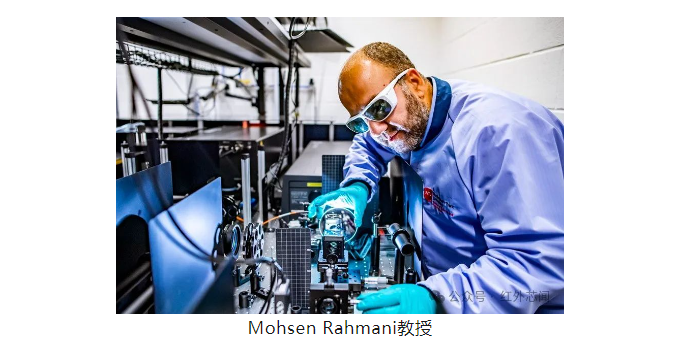31
2024
-
12
Next-generation high-quality, low-cost revolutionary full infrared band imaging technology
Author:
According to a report by Memes Consulting, recently, Professor Mohsen Rahmani from Nottingham Trent University (NTU) announced that his research team is developing a revolutionary infrared imaging technology that can achieve high-resolution imaging across the entire infrared spectrum. This breakthrough is expected to completely change the limitations of existing technologies.

The European Research Council has highly praised this innovative technology and decided to provide a grant of 3 million euros to Professor Mohsen Rahmani and his advanced optics and photonics team at the School of Science and Engineering at Nottingham Trent University to support their research work.
Although the visible camera technology in smartphones has matured and can provide high-resolution and clear imaging effects, infrared imaging (thermal imaging) cameras have not yet reached the same level of imaging quality. Currently, infrared cameras still face issues of image blurriness during operation, which limits their application in various fields.
Research predicts that the infrared imaging market size is valued at 7.03 billion dollars in 2023, and it is expected to grow to 12.36 billion dollars by 2032. Infrared cameras play a crucial role in various applications such as food quality control, night vision, medical imaging, and monitoring heat or gas leaks.
The research project at Nottingham Trent University - the Universal Platform for Infrared Imaging (UPIRI) - will achieve simultaneous detection across the entire infrared spectrum for the first time and can be seamlessly integrated into existing smartphones and conventional cameras.
Professor Mohsen Rahmani's research team will develop an artificially constructed nanoparticle array (metasurface) over a five-year period, which can absorb all infrared wavelengths and convert them into visible light. These metasurfaces can achieve pixelation, provide higher resolution, and can be independently controlled to switch between different infrared bands. The goal of this research is to provide a high-quality and low-cost alternative to expensive and complex infrared imaging technologies.
Professor Mohsen Rahmani stated: "Our long-term goal is to integrate all bands from visible light to infrared light through a low-cost device and achieve high-resolution imaging."
In addition, Mohsen Rahmani also stated: "Infrared cameras are crucial for many applications, but currently these applications rely on infrared cameras for different infrared bands, and no single camera can achieve full infrared band detection. These infrared cameras are often low in pixels, have poor image quality, are expensive, and consume a lot of energy."
The research team aims to provide a brand new complementary technology for visible light cameras, which can be easily integrated into standard cameras by creating a new type of compact metasurface.
Professor Richard Emes, Vice Chancellor for Research and International Relations at Nottingham Trent University, stated: "This funding is a recognition of the outstanding talent and research environment at Nottingham Trent University." Professor Richard Emes is extremely proud of Professor Mohsen Rahmani and his team and looks forward to the exciting results that this research will bring.
With the further development of this technology, it is expected to witness a revolutionary transformation of infrared imaging technology in various application fields, thus bringing new growth points to the global infrared imaging market.
LATEST NEWS
2025-01-09
Design and Development of Full-Spectrum Photodetectors
In recent years, the booming optoelectronic industry has changed the world and extended into many aspects of life. Among them, photodetectors (PDs) with a wide response bandwidth from deep ultraviolet to visible to near-infrared serve as important optoelectronic components and play a key role in daily life.
2025-01-08
Black arsenene multi-spectral integrated field-effect transistors, aiding high-resolution imaging and enhanced secure communication.
With the development of modern communication technology, the demand for broadband, room-temperature infrared, and terahertz (THz) detectors has rapidly increased. These detectors play a crucial role in fields such as telecommunications, security inspection, non-destructive testing, and medical diagnostics. However, existing optical detectors face challenges such as high intrinsic dark current and the need for low-temperature cooling, which limit their efficiency in detecting low-energy photons. Particularly in the terahertz band, the photon energy is insufficient to excite electron transitions from the valence band maximum (VBM) to the conduction band minimum (CBM), making effective optoelectronic conversion difficult. Therefore, researchers have been seeking ultra-broadband detectors that can operate at room temperature and respond to wavelengths ranging from visible light to the terahertz band.
2024-12-30
Laser-based tiered neurons achieve high-speed reservoir computing.
Neuromorphic computing is a computational paradigm that simulates the functions and architecture of biological neurons. A single biological neuron is a powerful computational unit with information processing capabilities, information transmission abilities, and memory functions. Therefore, it is crucial to design a photonic neuromorphic processor that can truly emulate the powerful computational functions of biological neurons.
2025-01-01
Design and Development of Full-Spectrum Photodetectors
In recent years, the rapidly growing optoelectronic industry has changed the world and extended into many aspects of life. Among them, photodetectors (PDs) with a wide spectral response from deep ultraviolet to visible to near-infrared serve as important optoelectronic components and play a key role in daily life.
2024-12-31
High-sensitivity quantum dot photodetectors from deep ultraviolet to near-infrared
In recent years, the rapidly growing optoelectronic industry has changed the world and extended into many aspects of life. Among them, photodetectors (PD) with deep ultraviolet-visible-near infrared full spectrum detection response serve as important optoelectronic components, playing a key role in daily life.

